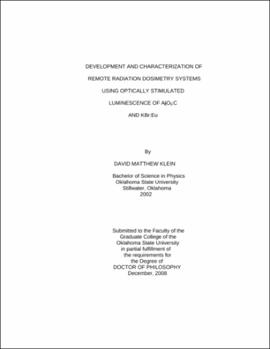| dc.contributor.advisor | McKeever, Stephen W. S. | |
| dc.contributor.author | Klein, David Matthew | |
| dc.date.accessioned | 2013-11-26T08:26:34Z | |
| dc.date.available | 2013-11-26T08:26:34Z | |
| dc.date.issued | 2008-12 | |
| dc.identifier.uri | https://hdl.handle.net/11244/6900 | |
| dc.description.abstract | Scope and Method of Study: To develop and test the performance of two different dosimetry systems; one for in situ, high-sensitivity, inexpensive environmental monitoring, and another for near-real-time medical dosimetry. The systems are based on remote interrogation of the optically stimulated luminescence (OSL) from Al2O3:C and KBr:Eu single crystal dosimeters (exposed to environmental and medical radiation fields, respectively) via fiber optic cables. The environmental system was tested in lab conditions using various radioactive sources including 60 Co, 90 Sr, 137 Cs, and 226 Ra, as well as with 232 Th-enriched soil stimulant. The medical system was tested under various diagnostic x-ray systems, including fluoroscopy and computed tomography (CT) machines, as well as with high dose rate 192 Ir brachytherapy sources and 232 MeV proton therapy beams under simulated treatment conditions. | |
| dc.description.abstract | Findings and Conclusions: The environmental system was shown to achieve sensitivity high enough for measuring an OSL signal resulting from a dose of ~1 uGY, which is equivalent to ~12 hours of natural background radiation. This sensitivity allows for monitoring of the radiation characteristics of a natural environment more rapidly and/or less expensively than existing methods, such as soil sampling and in situ gamma spectroscopy. The KBr:Eu-based medical system results show that the near-real-time data acquisition during irradiation allows for rapid quality assurance (QA) measurements that benefits from high spatial resolution. These features are not present in most current standard dosimeters such as thermoluminescent detectors and pencil ionization chambers. The dosimeter does exhibit energy dependence, and a sensitization during high dose rate procedures. As a result, a model has been proposed that provides a description of the possible mechanisms that govern the transfer of electrons and holes within KBr:Eu during OSL measurement at room temperature. Correction factors for these effects must be investigated for the system to become relevant for accurate dosimetry, rather than rapid QA. | |
| dc.format | application/pdf | |
| dc.language | en_US | |
| dc.rights | Copyright is held by the author who has granted the Oklahoma State University Library the non-exclusive right to share this material in its institutional repository. Contact Digital Library Services at lib-dls@okstate.edu or 405-744-9161 for the permission policy on the use, reproduction or distribution of this material. | |
| dc.title | Development and characterization of remote radiation dosimetry systems using optically stimulated luminescence of Al2O3:C and KBr:Eu | |
| dc.contributor.committeeMember | Ackerson, Bruce J. | |
| dc.contributor.committeeMember | Lucca, Don A. | |
| dc.contributor.committeeMember | Wicksted, James P. | |
| osu.filename | Klein_okstate_0664D_10089.pdf | |
| osu.accesstype | Open Access | |
| dc.type.genre | Dissertation | |
| dc.type.material | Text | |
| dc.subject.keywords | al2o3:c | |
| dc.subject.keywords | kbr:eu | |
| dc.subject.keywords | nuclear waste monitoring | |
| dc.subject.keywords | radiation dosimetry | |
| dc.subject.keywords | real-time dosimetry | |
| thesis.degree.discipline | Physics | |
| thesis.degree.grantor | Oklahoma State University | |
